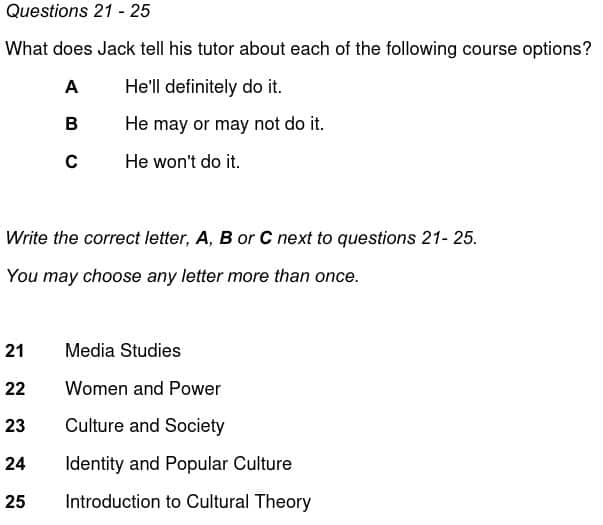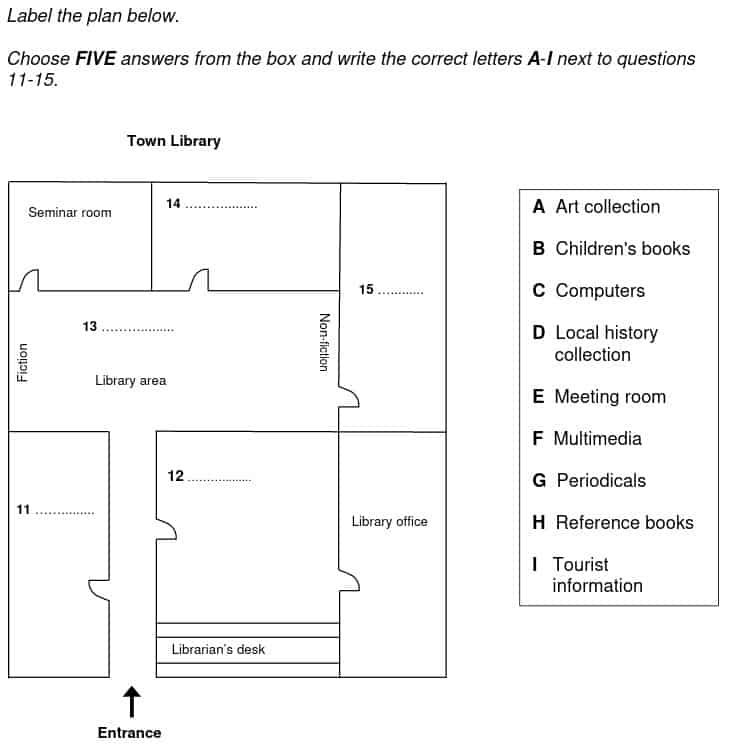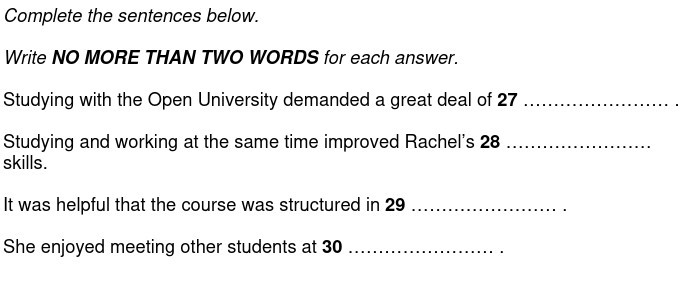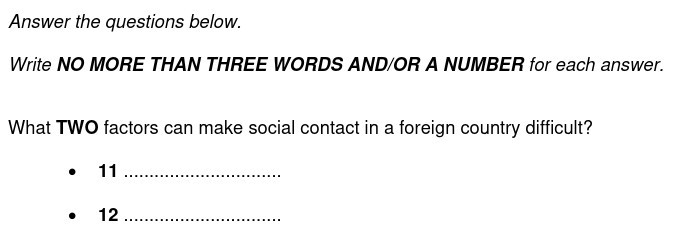Preparing for your IELTS test can be an ordeal. You need to prepare for all four major language skills on the test (reading, listening, reading, and writing), while also understanding the format and question types you will be asked.
Many students think the listening and reading portions of the test are easy. If you are one of those students, you shouldn’t let that stop you from spending time preparing for the listening test. Doing practice questions and understanding the test format can be the difference between passing and failing.
Here are tips you should keep in mind for your IELTS listening test to maximize your band score:
- Read the Questions First.
- Practice Multitasking.
- Answer All Questions.
- Avoid Tunnel Vision.
- Understand the Question Types.
- Transfer Answers Carefully.
- Practice.
Format
As usual, before we begin looking in depth at the tips, it’s important that we discuss the format of the IELTS listening test. Aside from your listening skills, knowing and understanding the listening test format is vital to your success.
You should clearly understand how long you have for the test, its purpose, and how many points you need to achieve to reach your goals.
The IELTS listening test is 30 minutes in total. The test will consist of four parts, each with 10 questions. Each part will have a different recording of individuals and groups of native English speakers in varying contexts .
Following is a description of the four recordings in the test:
- Recording 1 – An everyday conversation between two speakers.
- Recording 2 – A monologue set in an everyday context.
- Recording 3 – A conversation between 2 – 4 people in an education or training context.
- Recording 4 – A monologue about a university topic.
What band score do you need?
There will be a total of 40 questions that you must answer during the test. Depending on the band score you need, you will need to achieve a certain number of correct answers. Below you can find a table outlining the thresholds for band scores between 5 and 8.
It’s a good idea to understand the score you need to aim for in order to receive the band score that you need for your purposes. It’s a good idea to aim for one band score above what you need so that you have a good buffer area. That means if you need a band score of 7, you should aim to get a band score of 8.
| Band score | Score out of 40 |
|---|---|
| 8 | 35 |
| 7 | 30 |
| 6 | 23 |
| 5 | 16 |
1. Read the Questions First.
Before each recording, you should take advantage of the time before the recording begins to review the questions. Doing this will allow you to focus more clearly on the answers you need.
There will be more information presented in the test than you need to answer the questions. This is why pre-reading questions is vital.
You should pay attention to things like:
- What type of question it is.
- What information it’s asking for.
- How many words you need to write.
- Sometimes the test will ask for more than one word.
- Here’s how those words are calculated:
- hyphenated words are one word. e.g. part-time
- dates and numbers are one word. e.g. 2020/100,500
- compound words with a space are two words. e.g. garbage truck
Identifying all of this information before the recording starts means you will be able to be more focused on the conversations. You will be able to engage in active listening easier if you have something to listen for.
2. Practice Multitasking.
The listening test demands that you handle doing multiple things at the same time. You will need to keep track of your answers while actively listening to the recording.
The recording will only be played once. This means that you only have one chance to collect all of your answers because you won’t hear it again.
So it’s important that you get used to doing these multiple tasks at once. You should be able to answer the questions while listening to the recording at the same time.
3. Answer All the Questions.
The listening test is 40 questions in total. It’s important to know that any wrong answers you write won’t subtract from your final score, so you should try and fill in all of the questions that you can.
Even if you have to guess, you might get the question right, so make sure you are filling in all the blank spaces on your answer sheet. Remember to manage your time effectively though.
It isn’t worth missing multiple answers because you were too focused on trying to answer a single question.
4. Avoid Tunnel Vision.
This tip goes hand-in-hand with the last one. You want to try to fill in as many of the questions as possible. However, you don’t want to be so focused on the answer for a single question and end up missing the following questions because of it.
If you miss the answer to a question and you don’t have any idea what to write, it’s okay to skip that question and move on to the next one. It’s important that you answer as many of the questions as you can, so you don’t want to waste time focusing on one question while the answers to others are on their way.
In order to achieve a band score of 8, you are able to miss 5 of the questions. You can miss a total of 10 if you need a band score of 7. This means that you can relax a bit while answering the questions. You have a bit of wiggle room in order to achieve your goals.
5. Understand the Question Types.
There are a total of 5 different question types for the listening test. These will require you to answer them in different ways, so it’s a good idea for you to familiarize yourself with them prior to your test.
Multiple Choice

The multiple choice question is the same as you would find on any other test. You will be given a question and you must select the most correct choice from the list.
Sometimes you will be required to select more than one answer. Carefully read the question to ensure you select the correct number of answers.
Matching

Matching questions consist of two lists. One list is content from the recording, while the other is a list of descriptions or answers which match with each of the items in the list.
You will have to correctly match each item in the list with the correct answers.
Plan, map, diagram labelling

This question type requires you to accurately label an imagine. You will receive a box of labels (the amount of items varies) and a plan, diagram, or map that you must apply the correct item to from the list.
The question above is an example of a plan labelling question. Other types of images you may receive are diagrams (of a machine or piece of equipment) or a map.
Form, note, table, flow-chart, summary completion

In these questions, you will find a partially filled in form, note, table, etc. The question requires you to fill in the blank spaces with information you hear in the recording.
These question types are difficult to guess the answers for, so it’s important that you focus carefully during these questions to avoid missing any vital information.
Carefully read the question. It may place a limit on the amount of words you need to write in each blank space. Be careful not to write too many or too few words as you will be penalized if you do.
Sentence completion

This question type contains summary sentences for information contained in the listening recordings. You will have to fill in the correct information from the recording and use it to complete each of the sentences.
The sentence completion question type is another where you should carefully read the question prompt. You will have to fill in a specific number of words (either one, two, or three words). Be careful that you don’t include too many or too few as you will be penalized if you do.
Your grammar is also important for this question type. Ensure you complete each sentence in a grammatically correct way.
Contractions are not tested.
Short-answer questions

This question type requires you to read a question and write a short-answer to complete it.
Pay careful attention to the word limit for each answer. You want to make sure you are not including too many or too few words in each of your answers. For example, the question above requires you to write NO MORE THAN THREE WORDS AND/OR A NUMBER.
This means that you will either be writing a short three word answer and/or writing one number.
6. Transfer Answers Carefully.
You will be given an extra 10 minutes at the end of all the recordings to transfer your answers to the answer sheet.
This means that while you are listening, you do not need to worry about writing your answers on the answer sheet. You can write them directly onto the question sheet and worry about transferring them later.
However, you should be careful while doing this. The test expects you to spell all of your answers correctly and use appropriate grammar too. If you make a mistake, even if your answer is right, it will be marked wrong.
7. Practice.
Practice will be vital to your success with the listening test. It’s the same as all parts of the IELTS exam.
The expectations of the examiners are:
Assessors will be looking for evidence of your ability to understand the main ideas and detailed factual information, the opinions and attitudes of speakers, the purpose of an utterance and evidence of your ability to follow the development of ideas.
source
The test will require you to focus on answering questions while listening to the recording at the same time. Your abilities to multitask will be tested as well as your ability to actively listen.
The best way to ensure you are prepared for this is by practicing sample listening tests and trying to emulate the testing environment.
You should try to keep your practice as similar to your test day as possible. This means you should only listen to the practice tests once and practice transferring your answers onto the answer sheet.
This type of experience will make sure that when you go to your testing center on test day, you will be as prepared as possible to do the test with as few surprises as possible.
Conclusion
These are the best tips available for success during the IELTS listening test. If you implement each of these tips on test day, you are guaranteed the best possible environment for success.
Preparing for the IELTS test can be difficult. Each part of the test is designed to find the limits of your English abilities. They all require you to display specific abilities in a certain way. This demands focused practice and attention to the test’s details that can feel overwhelming.
This is why professional coaching can be a valuable investment for your success. Don’t waste your time and money retaking the test. An experienced coach can ensure you achieve your goal on test day and finish IELTS for good.
If you would like to receive personalized coaching about IELTS listening or any other part of the test, feel free to contact me here.



